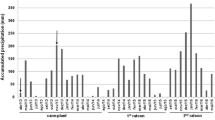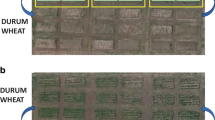Abstract
While integrated crop-livestock systems including trees have received more attention during the last two decades, the epidemiology of plant diseases in these production systems is still poorly understood. Microclimatic modifications due to the type of cropping system adopted may affect the epidemic patterns. This work aimed to evaluate whether powdery mildew severity on oats (Avena strigosa and A. sativa) and on soybean (Glycine max) are affected by the cropping system and which microclimatic factors are associated with disease development. A long-term experiment was conducted to compare three systems: agropastoral (AP), agrosilvopastoral (ASP) and non-integrated crop (CO). Two rates of nitrogen (N) were applied for AP and ASP. Powdery mildew severity on oats in ASP was approximately 20× greater than in the others systems. On soybean, powdery mildew varied across systems but it was more severe in ASP, with at least 4× greater disease severity than in the other systems. Likewise, conidia of Microsphaera diffusa collected in spore traps in ASP were consistently higher than in the others systems. ASP showed shorter leaf wetness duration, higher daylight relative humidity (RH), and lower temperature amplitude compared with the other systems. Multiple regression analysis showed that leaf wetness duration and daylight RH explained best the disease variation on soybean. Our data suggest that microclimatic conditions in the ASP system are likely the main drivers of more severe powdery mildew epidemics.






Similar content being viewed by others
References
Agam N, Berliner PR (2006) Dew formation and water vapor adsorption in semi-arid environments - a review. J Arid Environ 65:572–590
Altieri MA (1999) The ecological role of biodiversity in agroecosystem. Agric Ecosyst Environ 74:19–31
Alves, M de C, Pozza EA, Costa, J de C do B Ferreira Jb, de Araújo DV (2009) Intensidade de oídio Microsphaera diffusa Cke. & Pk. em cultivares de soja [Glycine max (L.) Merr.] sob diferentes temperaturas e períodos de molhamento foliar. Cienc Agrotec 33:1926–1930
Amsalem L, Freeman S, Rav-David D, Nitzani Y, Sztejnberg A, Pertot I, Elad Y (2006) Effect of climatic factors on powdery mildew caused by Sphaerotheca macularis f. Sp. fragariae on strawberry. Eur J Plant Pathol 114:283–292
Austin CN, Wilcox WF (2012) Effects of sunlight exposure on grapevine powdery mildew development. Phytopathology 102:857–866
Barrera W, Hoy J, Li B (2012) Temperature and leaf wetness effects on infection of sugarcane by Puccinia melanocephala. J Phytopathol 160:294–298
Bates D, Maechler M, Bolker B, Walker S (2014) lme4: linear mixed-effects models using Eigen and S4. R package version 1.1–5. http://cran.r-project.org/package=lme4. Accessed 25 Aug 2015
Bell LW, Moore AD (2012) Integrated crop-livestock systems in Australian agriculture: trends, drivers and implications. Agric Syst 111:1–12.
Beysens D (1995) The formation of dew. Atmos Res 39:215–237
Cherewick W (1944) Studies on the biology of Erysihe graminis D. C. Can J Res 22C:52–86
Dean R, Van Kan JAL, Pretorius ZA, Hammond-Kosack KE, Di Pietro A, Spanu PD, Rudd JJ, Dickman M, Kahmann R, Ellis J, Forster GD (2012) The top 10 fungal pathogens in molecular plant pathology. Mol Plant Pathol 13:414–430. doi:10.1111/j.1364-3703.2011.00783.x
Dietz J, Leuschner C, Hölscher D, Kreilein H (2007) Vertical patterns and duration of surface wetness in an old-growth tropical montane forest, Indonesia. Flora 202:111–117
de Faccio Carvalho PC, Anghinoni I, de Moraes A, de Souza ED, Sulc RM, Lang CR, Flores JPC, Lopes MLT, da Silva JLS, Conte O, de Lima Wesp C, Levien R, Fontaneli CB (2010) Managing grazing animals to achieve nutrient cycling and soil improvement in no-till integrated systems. Nutr Cycl Agroecosystems 88:259–273. doi:10.1007/s10705-010-9360-x
de Faccio Carvalho PC, de Moraes A, da Pontes LS, Anghinoni I, Sulk RM, Batello C (2014) Definições e terminologias para Sistema Integrado de Produção Agropecuária. Rev Cienc Agron 5:1040–1046
FAO (2010) An international consultation on integrated crop-livestock systems for development: the way forward for sustainable production intensification. Integr Crop Manag 13:1–79
Fehr WR, Caviness CE (1977) Stages of soybean development. Iowa State University, Ames
Gamble JD, Johnson G, Sheaffer CC, Current DA, Wyse DL (2014) Establishment and early productivity of perennial biomass alley cropping systems in Minnesota, USA. Agrofor Syst 88:75–85. doi:10.1007/s10457-013-9657-2
Glawe DA (2008) The powdery mildews: a review of the world’s most familiar (yet poorly known) plant pathogens. Annu Rev Phytopathol 46:27–51
Grainger J (1947) The ecology of Erysiphe graminis DC. Trans Br Mycol Soc 31:54–65
Haan CD, Steinfeld H, Blackburn H (1997) Livestock & the environment: finding a balance http://www.fao.org/docrep/x5303e/x5303e00.htm
Harterreiten-Souza ÉS, Togni PHB, Pires CSS, Sujii ER (2014) The role of integrating agroforestry and vegetable planting in structuring communities of herbivorous insects and their natural enemies in the Neotropical region. Agrofor Syst 88:205–219
Hothorn T, Bretz F, Westfall P (2008) Simultaneous inference in general parametric models. Biom J 50:346–363
Hughes RN, Brimblecombe P (1994) Dew and guttation: formation and environmental significance. Agric For Meteorol 67:173–190
Kang S-T, Mian MAR (2010) Genetic map of the powdery mildew resistance gene in soybean PI 243540. Genome 53:400–405
Koech EK, Whitbread R (2006) Incidence and severity of bean rust (Uromyces appendiculatus) in alleys between Leucaena hedgerows in Kenya. New For 31:385–402
Luo W, Goudriaan J (2000) Measuring dew formation and its threshold value for net radiation loss on top leaves in a paddy rice crop by using the dewball: a new and simple instrument. Int J Biometeorol 44:167–171
Maas B, Clough Y, Tscharntke T (2013) Bats and birds increase crop yield in tropical agroforestry landscapes. Ecol Lett 16:1480–1487
Malézieux E, Crozat Y, Dupraz C, Laurans M, Makowski D, Ozier-Lafontaine H, Rapidel B, De Tourdonnet S, Valantin-Morison M (2009) Mixing plant species in cropping systems: concepts, tools and models. A review. Agron Sustain Dev 29:43–62. doi:10.1051/agro:2007057
Manners J, Hossain S (1963) Effects of temperature and humidity on conidial germination in Erysiphe graminis. Trans Br Mycol Soc 46:225–234
Matson PA (1997) Agricultural intensification and ecosystem properties. Science (80- ) 277:504–509.
Mattiazzi P (2003) Efeito do oídio (Micrhosphaera diffusa Cooke & Peck) na produção e duração da área foliar sadia da soja. MSc Thesis, Universidade de São Paulo, Piracicaba, SP, Brazil
Mignucci J (1989) Powdery mildew. In: Sinclair J, Backman P (eds) Compendium of soybean diseases, 3rd edn. American Phytopathological Society, Saint Paul, pp 19–21
de Moraes A, de Faccio Carvalho PC, Anghinoni I, Lustosac SBC, Costa SEVG de A, Kunrath TR (2014a) Integrated crop-livestock systems in the Brazilian subtropics. Eur J Agron 57:4–9. doi:10.1016/j.eja.2013.10.004
de Moraes A, de Faccio Carvalho PC, Lustosa SBC, Lang CR, Deiss L (2014b) Research on integrated crop-livestock systems in Brazil. Rev Cienc Agron 45:1024–1031
Mwale VM, Chilembwe EHC, Uluko HC (2014) Wheat powdery mildew (Blumeria graminis f. Sp. tritici): damage effects and genetic resistance developed in wheat (Triticum aestivum). Int Res J Plant Sci 5:1–16
Narváez DF, Jurick WM II, Marois JJ, Wright DL (2010) Effects of surface wetness periods on development of soybean rust under field conditions. Plant Dis 94:258–264
Pap P, Rankovc B, Masirevic S (2013) Effect of temperature, relative humidity and light on conidial germination of oak powdery mildew (Microsphaera alphitoides Griff. Et Maubl.) under controlled conditions. Arch Biol Sci 65:1069–1077
Peterson R, Campbell A, Hannah A (1948) A diagrammatic scale for estimating rust intensity on leaves and stems of cereals. Can J Res 26C:496–500
Phillips DV (1984) Stability of Microsphaera diffusa and the effect of powdery mildew on yield of soybean. Plant Dis 68:953–956
Poch TJ, Simonetti JA (2013) Ecosystem services in human-dominated landscapes: Insectivory in agroforestry systems. Agrofor Syst 87:871–879
Pumariño L, Sileshi GW, Gripenberg S, Kaartinena R, Barriosb E, Muchaned MN, Midegae C, Jonssona M (2015) Effects of agroforestry on pest, disease and weed control: a meta-analysis. Basic Appl Ecol 16:573–582. doi:10.1016/j.baae.2015.08.006
R Core Team (2017). R: A language and environment for statistical computing. R Foundation for Statistical Computing, Vienna, Austria. https://www.R-project.org/
Rabbinge R, Jorritsma ITM, Schans J (1985) Damage components of powdery mildew in winter-wheat. Netherlands J Plant Pathol 91:235–247
Reis EM, dos Santos HP (1985) População de Helminthosporium sativum no ar quantificado através de uma armadilha tipo cata-vento. Fitopatol Bras 10:515–519
Reunião et al (2009) Indicações Técnicas para a Cultura da Soja no Rio Grande do Sul e em Santa Catarina 2009/2010. Embrapa Trigo, Passo Fundo
Ribeiro Jr P, Diggle P (2015) geoR: analysis of geostatistical data. R package version 1.7–6. http://www.leg.ufpr.br/geoR. Accessed 25 Aug 2015
Rowlandson T, Gleason M, Sentelhas, Gillespie T, Thomas C, Hornbuckle B (2015) Reconsidering leaf wetness duration determination for plant disease management. Plant Dis 99:310–319. doi:10.1094/PDIS-05-14-0529-FE
Ryschawy J, Choisis N, Choisis JP, Joannon A, Gibon A (2012) Mixed crop-livestock systems: an economic and environmental-friendly way of farming? Animal 6:1722–1730. 10.1017/S1751731112000675
Sarkar D, Andrews F (2013) latticeExtra: extra graphical utilities based on lattice. R package version 0.6–26
Schnathorst WC (1965) Environmental relationships in the powdery mildews. Annu Rev Phytopathol 3:343–366
Schroth G, Krauss U, Gasparotto L, Duarte Aguilar, JA, Vohland K (2000) Pests and diseases in agroforestry systems of the humid tropics. Agrofor Syst 50:199–241
Shaner G (1981) Effect of environment on fungal leaf blights of small grains. Annu Rev Phytopathol 19:273–296
Sivapalan A (1993) Effects of water on germination of powdery mildew conidia. Mycol Res 97:71–76
Smiley RW, Dernoeden PH, Clarke BB (1992) Compendium of Turfgrass diseases, 2nd edn. APS Press, St. Paul
Thornton PK, Herrero M (2001) Integrated crop-livestock simulation models for scenario analysis and impact assessment. Agric Syst 70:581–602
Twomey MC, Wolfenbarger SN, Woods JL, Gent DH (2015) Development of partial ontogenic resistance to powdery mildew in hop cones and its management implications. PLoS One 10:1–24
Wang H, Jiang YP, Yu HJ, Xia XJ, Shi K, Zhou YH, YU JQ (2010) Light quality affects incidence of powdery mildew, expression of defence-related genes and associated metabolism in cucumber plants. Eur J Plant Pathol 127:125–135. doi:10.1007/s10658-009-9577-1
Ward SV, Manners JG (1974) Environmental effects on the quantity and viability of conidia produced by Erysiphe graminis. Trans Br Mycol Soc 62:119–128
Wezel A, Casagrande M, Celette F, Vian J-F, Ferrer A, Peigné J (2014) Agroecological practices for sustainable agriculture. A review. Agron Sustain Dev 34:1–20. doi:10.1007/s13593-013-0180-7
Willocquet L, Colombet D, Rougier M, Fargues J, Clerjeau M (1996) Effects of radiation, especially ultraviolet B, on conidial germination and mycelial growth of grape powdery mildew. Eur J Plant Pathol 102:441–449. doi:10.1007/BF01877138
Wrather JA, Anderson TR, Arsyad DM, Tan Y, Ploper LD, Porta-Puglia A, Ram HH, Yorinori JT (2001) Soybean disease loss estimates for the top ten soybean-producing countries in 1998. Can J Plant Pathol 23:115–121
Yamoah CF, Burleigh JR (1990) Alley cropping Sesbania sesban (L) Merill with food crops in the highland region of Rwanda. Agrofor Syst 10:169–181
Zadoks JC, Chang TT, Konzak CF (1974) A decimal code for the growth stages of cereals. Weed Res 14:415–421
Acknowledgements
This work was supported by the SERVIAMBI project (Scientific Cooperation Term 21500.10/0008-2, signed between IAPAR and Embrapa Florestas) and also by grants by CNPq PROCAD (project number 552334/2011-1) and CAPES.
Author information
Authors and Affiliations
Corresponding author
Additional information
Section Editor: Paul D. Esker
Rights and permissions
About this article
Cite this article
Roese, A.D., Ribeiro, P.J. & De Mio, L.L.M. Microclimate in agrosilvopastoral system enhances powdery mildew severity compared to agropastoral and non-integrated crop. Trop. plant pathol. 42, 382–390 (2017). https://doi.org/10.1007/s40858-017-0162-4
Received:
Accepted:
Published:
Issue Date:
DOI: https://doi.org/10.1007/s40858-017-0162-4




